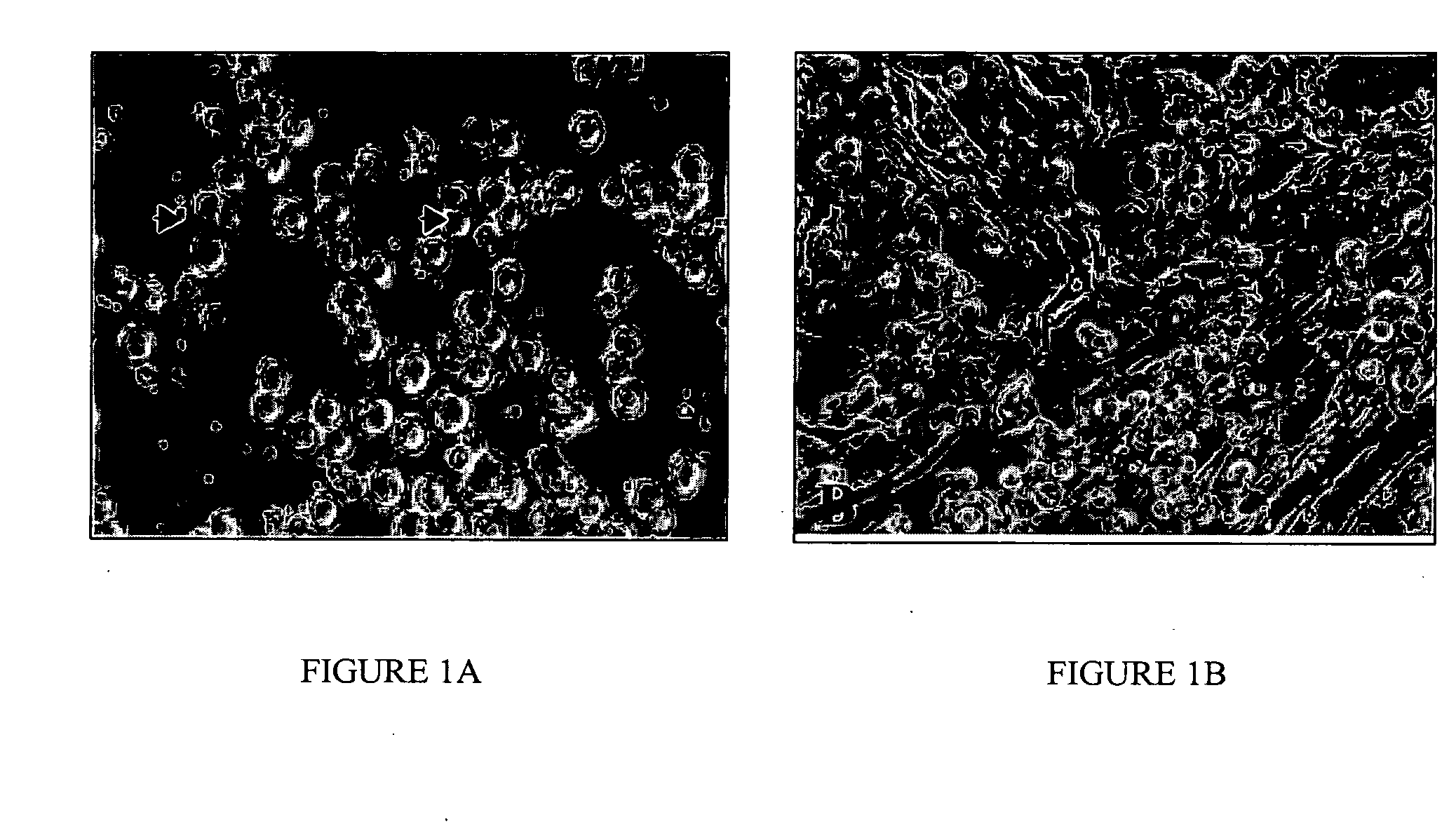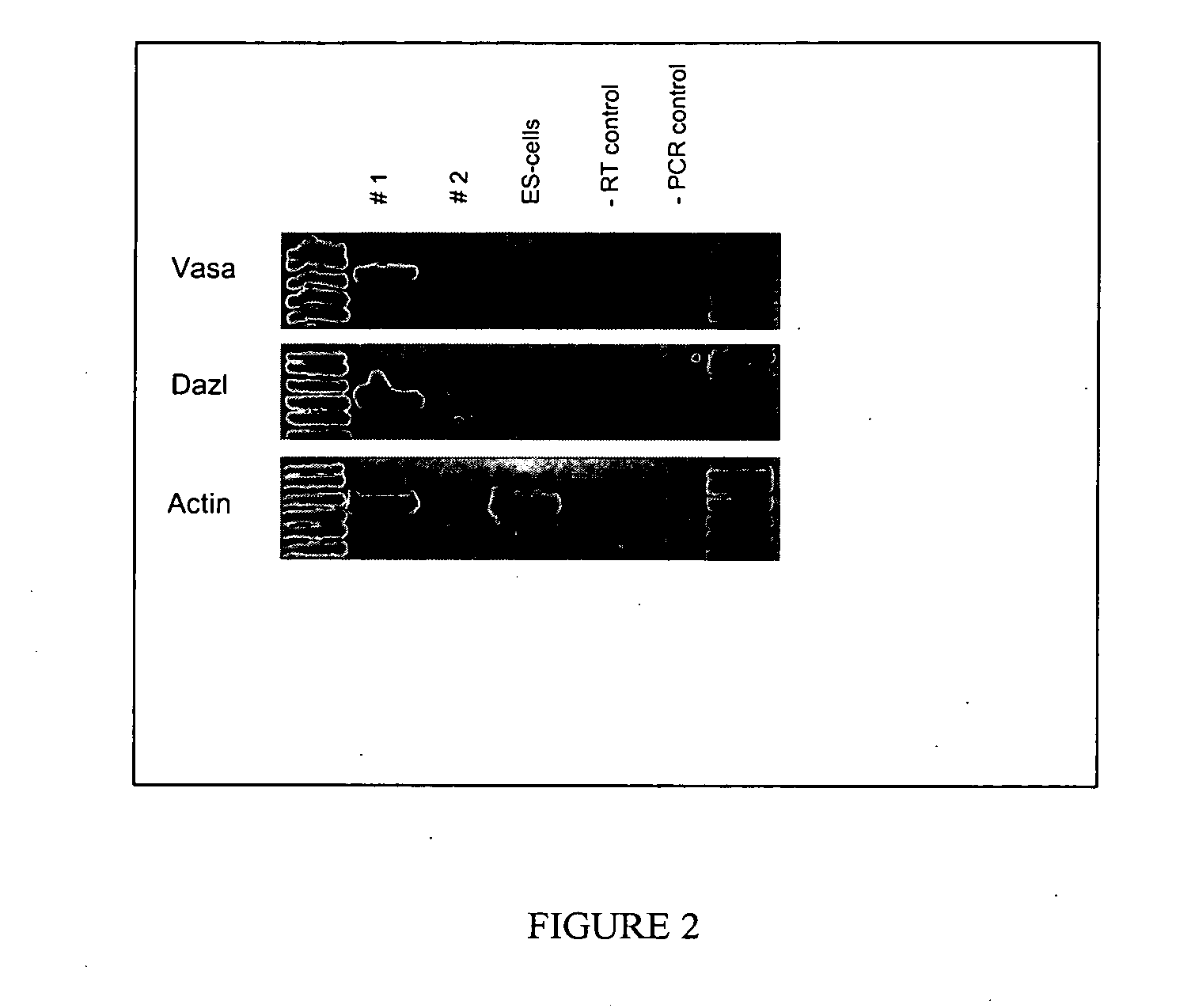[0051] The PGCs of the invention can be obtained by any known technique and grown in the culture conditions described herein. However, it is preferred that
whole blood is removed from a stage 15
embryo and is placed directly in the culture media described below. This approach differs from other approaches described in the literature wherein PGCs are subjected to
processing and separation steps prior to being placed in culture. Unlike conventional culture techniques, the culture and methodology of the present invention relies on robust differential growth between PGCs and other cells from
whole blood that may initially coexist in the tedium, in order to provide the large populations of PGCs in culture described here. Accordingly, the present invention provides culture of PGCs derived directly from
whole blood that grow into
large cell concentrations in culture, can go through an unlimited number of passages, and exhibit robust growth and proliferation such that the PGCs in culture are essentially the only cells growing and proliferating. These culture conditions provide an important
advantage of the present invention, thereby rendering the collection, storage, and maintenance of PGCs in culture particularly simple and efficient and providing a readily available source of donor cells to create
germline chimeras that pass the
genotype of cultured PGC cells to
offspring.
[0052] The PGCs maintained in culture by the inventors have demonstrated the existence of a non-terminal culture and have currently existed for at least 327 days in culture. These cells are growing and proliferating in the same manner as was observed at 40, 60, 80, or 100 days (and all integral values therein) and the cells continue to contribute to germline chimeras as described below, and thus, exhibit the primary distinguishing characteristics of true PGCs, i.e., the exclusive contribution to the germline when introduced into a recipient
embryo. The culture methodology of the invention includes using whole blood, which contains red blood cells and other metabolically
active cell types, placing a mixture of cells into culture along with primordial germ cells and allowing the culture to evolve to consist essentially of avian PGCs displaying the long-term culture characteristics described herein.
Cell culturing technology described herein avoids any
cell separation processes or techniques and relies solely on differential growth conditions to yield the predominance of PGCs in culture. The use of whole blood as the source of the established and cultured PGC cells offers practical advantages in the efficiency and utility of establishing the cultures and using the cells for agricultural or transgenic purposes. Accordingly, in one aspect of the invention, the culture medium is conditioned with BRL (Buffalo
Rat Liver cells), contains
fibroblast growth factors,
stem cell factor, and
chicken serum. The particular characteristics of the medium are described in greater detail below.
[0053] In one aspect of the present invention, a culture is established that has a large number of PGCs that are genetically identical and which proliferate to yield a long-term
cell culture. These PGCs can be used repeatedly to create germline chimeras by introducing the PGCs from a proliferating long-term culture to recipient embryos. In previous attempts to use PGCs to create germline chimeras, the number of chimeras that could be created was inherently limited by the inability to grow long-term cultures of true PGCs that retain the PGC
phenotype. Because long-term cultures are enabled by the present invention, any number of germline chimeras can be created from the same
cell culture and an
entire population of germline chimeras can be established having genetically identical, PGC-derived germlines. Accordingly, one aspect of the present invention is the creation of large numbers, including greater than 3, greater than 4, greater than 5, 10, 15 and 20 germline chimeric animals all having genetically identical PGC-derived cells in their germline. Another aspect of the invention is the creation of a
population of germline chimeras having genetically identical PGC-derived cells in their germline that have, within the
population, age differentials that reflect the use of the same long-term
cell culture to create germline chimeras. The age differentials exceed the currently available ability to culture primordial germ cells over time and are as high as 190 days without freezing. Accordingly, the present invention includes two or more germline chimeras having identical PGC-derived cells in their germline that differ in age by more than 40 days, 60 days, 80 days, 100 days, 190 days, etc., or any other integral value therein—without freezing the cells. The invention also includes the existence of sexually mature germline chimeras having genetically identical PGC-derived cells in their germline, together with the existence of a non-terminal PGC culture used to create these germline chimeras and from which additional germline chimeras can be created.
[0054] Because the PGCs can be maintained in culture in a manner that is extremely stable, the cells can also be cryo-preserved and thawed to create a long-term storage methodology for creating germline chimeras having a capability to produce
offspring defined by the
phenotype of the PGCs maintained in culture.
[0055] The capability to produce large numbers of germline chimeras also provides the ability to pass the PGC-derived
genotype through to offspring of the germline chimera. Accordingly, the present invention includes both populations of germline chimeras having genetically identical PGC-derived cells in the germline, but also offspring of the germline chimeras whose
genotype and
phenotype is entirely determined by the genotype of the PGCs grown in culture. Transmission of a PGC-derived phenotype through the germline has been observed for more than 20 birds at transmission percentages as high as 86%. Thus, the invention includes the offspring of a germline chimera created by germline transmission of a genotype of a
primordial germ cell held in culture. Accordingly, the invention includes each of the existence of a
primordial germ cell culture containing PGCs of a defined phenotype, a germline chimera having the same primordial germ cells as part of its germline, and an offspring of the germline chimera having a genotype and phenotype dictated by the PGCs in culture.
[0056] As has been described previously, the existence of long-term PGC cultures enables the ability to stably transfect the cells in culture with
DNA encoding exogenous proteins or introducing other desirable genetic manipulations such as
gene insertions and knock-outs of a transgenic animal. Accordingly, all of the above-described populations of PGCs in culture, germline chimeras, and offspring of germline chimeras can also be comprised of
a DNA construct stably integrated into the
genome of the
primordial germ cell, transmitted into the germline of the germline chimera, and transmitted into future generations comprised of offspring of the germline chimeras.
 Login to View More
Login to View More 


